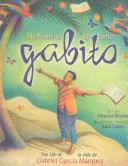
Gabriel Garcia Marquez is perhaps one of the most brilliant writers of our time. He is a tremendous figure, enormously talented, and unabashedly admired. This is his story, lovingly told, for children to enjoy. Using the imagery from his novels, Monica Brown traces the novelist’s life in this creative nonfiction picture book from his childhood in Colombia to today. This is an inspiring story about an inspiring life, full of imagination and beauty.
- ISBN: 9780873589086
- Author: Brown, Monica
- Published: 2007, Rising Moon
- Themes: Imagination, writer
- Descriptors: Bilingual, Biography - Autobiography- Memoir, Colombia, Intermediate (ages 9-14), Latin America, Primary (ages 6-9)
- No. of pages: 32

This is the story of the early life of Gabriel García Márquez. It told of his vivid imagination as a young child and of his early connection with his grandfather. Mention was made of his fascination with words and with his surroundings. It ends with the applause for his accomplishments and the fact that all of those early experiences have influenced his life and therefore his art.
The pictures were lovely and the narrative well written. The message was inspirational. The idea that there was a little boy, with a vivid imagination, who rose to write stories that would be read throughout the world, certainly made it a worthwhile read.
This book also provides an interesting perspecive on biography, incorporating beautifully elements of both narrative and informational text. As a part of a study on Latino historical figures, or as an author study forming part of a biography unit, Brown’s book invotes the readers to use their imagination, and provides an equally compelling invitation for the writer. To have the life of the subject so inspire a biography, so that it takes the shape of a part of their legacy is a true homage.
The author’s words are an incredible inspiration to anyone who reads them. The fact that it has Spanish and English text is simply ingenious and would engage the imagination of today’s diverse readers. The dedication of Brown’s story to portray all of Garcia Marquez’s magical style makes her book, My name is Gabito, a wonderful book to read and a great way to reach children.
A wonderful multicultural picture book, My Name is Gabito features modestly involved text and is ideal for young readers who are just about ready to enjoy chapter books. The flawless Spanish text alongside the English will also appeal to Spanish-language students of all ages seeking to hone their skills and fluency
My Name is Gabito/Me llamo Gabito: The Life of Gabriel García Márquez/La vida de Gabriel García Márquez by Monica Brown
We continue this month sharing books that celebrate the magic of words and bilingualism. This week we celebrate the life of a great Spanish speaking writer as described by Latina author Monica Brown. In the book My Name is Gabito/Me llamo Gabito: The Life of Gabriel García Márquez/La vida de Gabriel García Márquez, Monica Brown introduces children to the life of one of the most brilliant Latin Americans, Colombian Nobel Prize for Literature García Márquez. The dual language book makes the life of this outstanding Spanish-speaking writer available to both Spanish-and English-speaking children. Brown’s words and Raúl Colón’s illustrations describe García Márquez’s life in a way that invites the child reader to enter a world in which imagination has no limits. Brown writes:
“When Gabito grew up he wrote the most exciting
stories in the world. His stories were magical and
amazing, but just as real as you or me.
Can you imagine what kind of stories Gabito told?
Close your eyes and see.”
The reference and play with fantasy and real elements in Brown’s story and Colón’s illustrations evoke García Márquez’s style known as magical realism, a view of the real “that encompasses myth, magic. . . a view that blends reality and fantasy so that the distinction between the two erases” (http://mockingbird.creighton.edu/ncw/marquez.htm). A view of life that does not alienate the reader from the suffering of others and that Monica Brown captured so well in this book for children:
“Sometimes Gabito and his grandfather walked past the big banana plantation at the edge of town. He saw how hard the people on the banana plantation worked picking fruit. Even to little Gabito, it didn’t seem fair that those who worked so hard were so poor, and this made Gabito sad. He tried to imagine a world where no one was poor . . . The more things Gabito saw, the more stories he told.”
García Márquez’s concerns for social justice are evident in the words he wrote when he retired from public life:
“I have learned that a man has the right to look down on somebody only when he is helping him to get up.”
In the same document he conveyed his desires to reach children:
“If God allowed me one more piece of life . . . I would give wings to the children, but I would leave the child alone so that he could learn how to fly on his own” . . . http://www.youtube.com/watch?v=7AOh8L2AP0s&feature=related
Mónica Brown is helping García Márquez to make that wish a reality by putting this book in the hands of teachers, librarians, and children in Spanish-and English-speaking worlds and invite them to imagine and to write their own stories, as Gabito did. Would we accept this invitation?